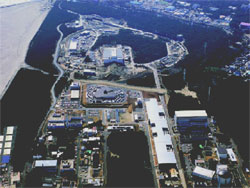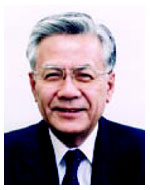|
|
|
Construction of J-PARC in Full Swing
Several years ago, KEK and the Japan Atomic Energy Research Institute (JAERI), which is now called the Japan Atomic Energy Agency (JAEA), started to work on a joint venture to construct a new proton accelerator with the highest beam power in the world. The new accelerator is targeted for a wide range of fields, using K-meson beams, neutrino beam, neutron beam and muon beam for nuclear and particle physics, materials science, biology and nuclear engineering. These beams will be generated by bombarding high-power proton beam on nuclei at rest. The accelerator facility is called J-PARC, which is an abbreviation for Japan Proton Accelerator Research Complex.
Construction of the J-PARC facility started in 2001 and the provision of beams is set to commence in 2008. Construction work is currently in full swing in both areas of accelerator construction and civil engineering. About two thirds of the construction has been completed. The photo shows the present status of construction.
The accelerator complex consists of a Linac, a 3 GeV Synchrotron and a 50 GeV Synchrotron. While they are connected in series to step up beam energy to the final 50 GeV, each step also provide beams for particular applications. The Linac provides high intensity beam for Transmutation experiments (not yet funded), the 3 GeV Synchrotron provides neutron and muon beams for Materials and Life Science experiments through beam conversion steps. The 50 GeV Synchrotron provides high intensity beam to Hadron Physics Facility as well as neutrino beam to Super-Kamiokande located 300km away.
Because the performance of the accelerator is largely determined at the first stage of the linear accelerator, the development of technology for this portion is of crucial importance. At the beginning of November 2003, a full prescribed performance was successfully attained. The beam test through the entire linear accelerator is planned at the end of 2006.
J-PARC will be open to the world as an international facility. The number of researchers from outside of Japan (North America, Europe and Asia) who wants to participate on the subject of nuclear and particle physics has already exceeded the number of Japanese researchers. J-PARC is expected to boost levels of participation in neutron-related fields from Asia and Oceanic regions. Preparation to accommodate large number of visiting researchers from all over the world is also going ahead in cooperation with local governments including Tokai-mura Village and the Ibaraki Prefecture.
It is anticipated that in a future J-PARC may become one of the leading centers in the world. With that in mind, the project team is working day and night to forge ahead with construction work. For those who have interests in J-PARC, please visit also http://j-parc.jp/index.html.
 |
An overall construction status of the J-PARC, as viewed from the sky. The photo was taken on February, 2006. |

The author of this article, Professor Shoji Nagamiya has been the head of J-PARC project.
|
|
